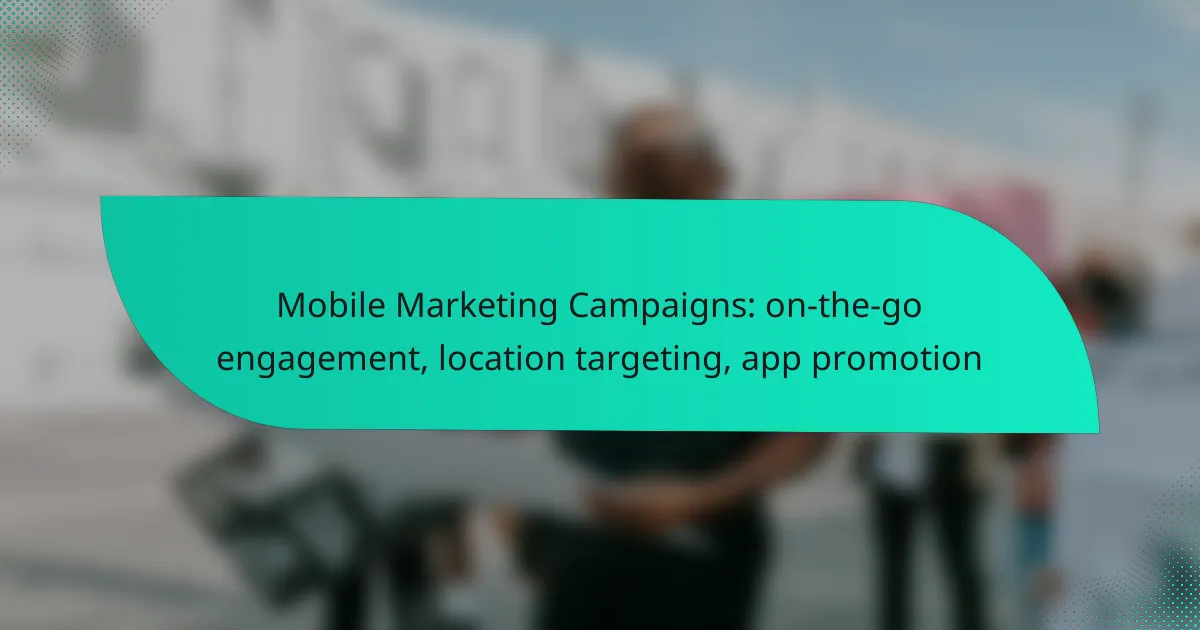Mobile marketing campaigns are essential for engaging audiences in today’s fast-paced environment, particularly through strategies like location targeting and app promotion. By leveraging real-time data and user preferences, businesses can create personalized experiences that resonate with consumers on the go. This approach not only enhances engagement but also drives conversions by delivering relevant messages at the right moment.

How to create effective mobile marketing campaigns in the UK?
Creating effective mobile marketing campaigns in the UK involves understanding your audience and utilizing strategies that enhance engagement and conversion. Key elements include location targeting, app promotion, and techniques that cater to users on the go.
Utilize location-based targeting
Location-based targeting allows marketers to send tailored messages to users based on their geographic location. This can significantly increase relevance and engagement, as users receive offers and information that are pertinent to their immediate surroundings.
Consider using geofencing, which sends notifications when users enter a predefined area, or proximity marketing that targets users in close range to your business. For example, a coffee shop might send a discount offer to users within a 500-meter radius.
Leverage app promotion strategies
Promoting your app effectively is crucial for driving downloads and user engagement. Utilize in-app advertisements, social media campaigns, and partnerships with influencers to reach potential users. Offering incentives, such as discounts or exclusive content, can also encourage downloads.
Consider running targeted ads on platforms like Facebook or Instagram, which allow precise demographic and interest-based targeting. Additionally, optimizing your app store listing with relevant keywords can improve visibility and attract more users.
Incorporate on-the-go engagement techniques
On-the-go engagement techniques are essential for capturing the attention of mobile users. This includes using push notifications, SMS marketing, and interactive content that encourages immediate interaction.
Ensure your messages are concise and actionable, prompting users to take advantage of time-sensitive offers. For example, sending a flash sale alert can drive quick responses. However, avoid overwhelming users with too many notifications, as this can lead to opt-outs.

What are the best practices for location targeting?
Effective location targeting in mobile marketing campaigns involves using precise geographical data to engage users in real-time. By leveraging technologies like GPS and Wi-Fi, marketers can deliver tailored messages that resonate with users based on their current location.
Use geofencing for real-time engagement
Geofencing creates virtual boundaries around specific locations, allowing businesses to send notifications or offers to users when they enter or exit these areas. This technique is particularly effective for driving foot traffic to physical stores or events.
To implement geofencing, define your target areas clearly and set up triggers for notifications. For example, a coffee shop could send a discount offer to customers who are within a 500-meter radius. However, be mindful of user privacy and ensure compliance with regulations like GDPR or CCPA.
Segment audience by location
Segmenting your audience based on location allows for more personalized marketing strategies. By analyzing user data, you can identify different preferences and behaviors in various regions, tailoring your messaging accordingly.
For instance, a clothing retailer might promote winter apparel in colder regions while highlighting summer collections in warmer areas. This localized approach can significantly enhance engagement and conversion rates, as users receive relevant content that meets their specific needs.

How can mobile apps enhance marketing efforts?
Mobile apps can significantly enhance marketing efforts by providing direct channels for engagement and personalized experiences. They allow businesses to reach users in real-time, leveraging location data and user preferences to create targeted promotions and interactions.
Integrate push notifications for user engagement
Push notifications are a powerful tool for increasing user engagement within mobile apps. They allow businesses to send timely updates, reminders, and personalized offers directly to users’ devices, encouraging interaction and retention.
To effectively use push notifications, consider segmenting your audience based on behavior and preferences. For example, a retail app might send exclusive discounts to users who frequently browse but rarely purchase. Aim for a notification frequency that keeps users informed without overwhelming them, typically a few times a week.
Optimize app store listings for visibility
Optimizing app store listings is crucial for improving visibility and attracting downloads. This involves using relevant keywords in the app title and description, ensuring high-quality visuals, and encouraging positive user reviews.
Focus on creating an appealing app icon and engaging screenshots that showcase the app’s features. Regularly update the app description to reflect new functionalities and promotions. Monitoring analytics can help identify which keywords drive traffic, allowing for ongoing adjustments to enhance discoverability.

What role does display advertising play in mobile marketing?
Display advertising is crucial in mobile marketing as it captures user attention through visually engaging ads on mobile devices. These ads can be strategically placed within apps or websites, targeting users based on their behavior and preferences.
Target specific demographics with display ads
Targeting specific demographics with display ads allows marketers to reach audiences based on age, gender, location, and interests. For instance, a local restaurant can use display ads to target food enthusiasts within a certain radius, increasing the likelihood of foot traffic.
Utilizing data analytics tools can help refine these demographics, ensuring that ads resonate with the intended audience. This approach enhances engagement and improves conversion rates, making campaigns more effective.
Measure campaign effectiveness through analytics
Measuring the effectiveness of mobile display advertising campaigns is essential for optimizing performance. Key metrics include click-through rates (CTR), conversion rates, and return on ad spend (ROAS). These metrics provide insights into how well the ads are performing and where adjustments may be needed.
Using analytics platforms, marketers can track user interactions in real-time, allowing for quick pivots in strategy if certain ads underperform. Regularly reviewing these analytics helps ensure that marketing budgets are spent efficiently and that campaigns achieve their desired outcomes.

What are the challenges of mobile marketing in urban areas?
Mobile marketing in urban areas faces significant challenges, primarily due to high competition and privacy concerns. Marketers must navigate a crowded landscape while respecting user privacy to effectively engage consumers on-the-go.
High competition for user attention
In urban environments, users are bombarded with messages from various brands, making it difficult for any single campaign to stand out. Effective mobile marketing strategies must leverage unique value propositions and compelling visuals to capture attention amidst this noise.
To break through the clutter, consider using personalized content that resonates with local interests or events. For example, promotions tied to nearby festivals or local sports teams can create a stronger connection with the audience.
Privacy concerns affecting targeting
Privacy regulations, such as the General Data Protection Regulation (GDPR) in Europe and the California Consumer Privacy Act (CCPA) in the U.S., impose strict guidelines on how marketers can collect and use consumer data. These regulations can limit the ability to target users effectively based on their location and preferences.
Marketers should prioritize transparency and obtain explicit consent when collecting data. Offering value in exchange for information, such as exclusive discounts or content, can encourage users to share their data willingly while ensuring compliance with privacy laws.

How to measure the success of mobile marketing campaigns?
To measure the success of mobile marketing campaigns, focus on key performance indicators (KPIs) such as conversion rates, return on investment (ROI), and user engagement metrics. These metrics provide insights into how well your campaigns are performing and where adjustments may be needed.
Track conversion rates and ROI
Tracking conversion rates is essential for understanding how many users take desired actions after interacting with your mobile marketing campaigns. This could include making a purchase, signing up for a newsletter, or downloading an app. Aim for a conversion rate that aligns with industry standards, typically ranging from 1% to 5% for mobile campaigns.
Calculating ROI helps determine the financial effectiveness of your campaigns. To calculate ROI, subtract the total cost of the campaign from the revenue generated, then divide by the total cost. A positive ROI indicates a successful campaign, while a negative ROI signals the need for reevaluation.
Analyze user engagement metrics
User engagement metrics reveal how effectively your mobile marketing campaigns capture and retain audience attention. Key metrics include click-through rates (CTR), time spent on the app or website, and the frequency of user interactions. A CTR of 2% to 5% is often considered good for mobile ads.
Consider using tools like Google Analytics or mobile app analytics platforms to track these metrics. Regularly review engagement data to identify trends and optimize your campaigns accordingly. High engagement often correlates with higher conversion rates, so focus on creating compelling content that resonates with your audience.

What emerging trends are shaping mobile marketing?
Emerging trends in mobile marketing are significantly enhancing how brands engage with consumers. Key developments include the increased use of artificial intelligence for personalization and the growth of augmented reality in advertising, both of which are reshaping user experiences and expectations.
Increased use of AI for personalization
Artificial intelligence is transforming mobile marketing by enabling brands to deliver highly personalized content and experiences. By analyzing user behavior and preferences, AI can tailor messages, product recommendations, and promotions to individual users, increasing engagement and conversion rates.
For effective AI-driven personalization, marketers should focus on collecting relevant data while respecting user privacy. Implementing machine learning algorithms can help predict user needs based on historical interactions, allowing for timely and relevant marketing efforts.
Growth of augmented reality in advertising
Augmented reality (AR) is becoming a powerful tool in mobile advertising, providing immersive experiences that engage users more deeply. Brands can use AR to allow customers to visualize products in their own environment, enhancing the decision-making process and driving sales.
To leverage AR effectively, marketers should create user-friendly applications that integrate seamlessly with mobile devices. Successful examples include virtual try-ons for clothing and makeup, which have shown to increase customer satisfaction and reduce return rates. Investing in AR technology can differentiate a brand in a crowded market, making it essential for forward-thinking marketers.

How to adapt mobile marketing strategies for future developments?
To adapt mobile marketing strategies for future developments, businesses should focus on integrating emerging technologies, enhancing user experience, and leveraging data analytics. Staying ahead of trends like 5G and location-based services will ensure effective engagement with on-the-go consumers.
Embrace new technologies like 5G
5G technology offers significantly faster data transfer rates and lower latency, which can enhance mobile marketing campaigns. This advancement allows for richer media experiences, such as high-definition video ads and augmented reality applications, making engagement more interactive and appealing.
To effectively utilize 5G, marketers should consider creating content that takes advantage of these capabilities. For instance, brands can develop immersive experiences that allow users to interact with products in real-time, increasing the likelihood of conversion. Additionally, ensure that your app or website is optimized for high-speed connections to fully leverage 5G benefits.
Common pitfalls include failing to update existing content for 5G compatibility or neglecting to analyze user behavior in a 5G environment. Regularly assess your mobile marketing strategies to ensure they align with technological advancements and consumer expectations.
